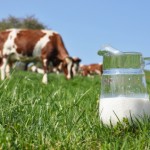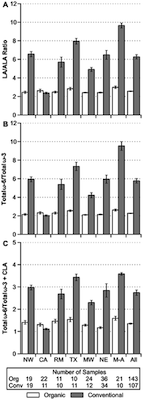By now you may have heard about a study from Washington State University that reports organic milk contains significantly higher concentrations of essential-fatty acids, compared to milk from cows on conventionally managed dairy farms. While this is not news to some, it is the first large-scale study of its  type. It cast a positive spotlight on how our agricultural system, specifically animal feed, is uniquely tied to human health.
type. It cast a positive spotlight on how our agricultural system, specifically animal feed, is uniquely tied to human health.
That said, for now, organic dairy is not a sufficient replacement all omega-3s, such as fish oil, say experts.
For physicians, the study illustrates how small changes in your patient’s diet can dramatically improve lipid levels, specifically for the balance of omega-6 and omega-3 fatty acids. The higher the ratio of omega-6 to omega-3, the greater the associated health risk for cardiovascular disease, cancer, excessive inflammation and autoimmune diseases.
When a hypothetical diet was applied for adult women, with a baseline omega-6 to omega-3 ratio of 11.3, the study looked at how far three interventions could go in reducing the ratio to 2.3. The study found:
• Almost 40 percent of the needed nine-point drop could be achieved by switching from three daily servings of conventional dairy products to 4.5 daily servings of mostly full-fat organic dairy products;
• Women who also avoided a few Omega-6 rich foods each day could lower their fatty acid ratio to around 4, 80 percent of the way to the 2.3 goal.
We were surprised by the magnitude of the nutritional quality differences we documented in this study,” said Charles Benbrook PhD, the study’s lead author from the Center for Sustaining Agriculture and Natural Resources at Washington State University, in a press statement.
Organic dairy consumption can significantly improve fatty acid intake for α-linolenic acid (ALA), but only small improvements for intake of eicosapentaenoic acid (EPA) and docosapentaenoic acid (DPA), and negligible for docosahexaenoic(DHA).
When comparing conventional and organic fluid milk, the study found:
• Averaged over 12 months, organic milk contained 25% less ω-6 fatty acids and 62% more ω-3 fatty acids than conventional milk;
• This yielded a 2.5-fold higher ω-6/ω-3 ratio in conventional compared to organic milk (5.77 vs. 2.28);
• All individual ω-3 fatty acid concentrations were higher in organic milk—α-linolenic acid (ALA by 60%), eicosapentaenoic acid (EPA 32%), docosapentaenoic acid (DPA 19%), conjugated linoleic acid (CLA 18%). Docosahexaenoic acid (DPA) was not present.
 We were surprised to find that recommended intakes of full-fat milk products supply far more of the major omega-3 fatty acid, ALA, than recommended servings of fish,” said co-author and WSU research associate Donald R. Davis in a press statement. Conventional milk had about nine times more ALA than fish while organic milk had 14 times more, he said.
We were surprised to find that recommended intakes of full-fat milk products supply far more of the major omega-3 fatty acid, ALA, than recommended servings of fish,” said co-author and WSU research associate Donald R. Davis in a press statement. Conventional milk had about nine times more ALA than fish while organic milk had 14 times more, he said.
The study put a stamp of approval on the premise that organic diary is significantly “healthier” than conventional – a point that has been argued for decades but without significant proof. The fact that animal feed an influence output of ALA will no doubt lead to more research in improving the fatty acid profile of organic dairy. But, the health properties of ALA are limited compared to EPA and DHA say experts outside this study.
For this reason, it is important not to over generalize the science to suggest that all Omega-3s are equal in terms of their impact to human health, says Adam Ismail, Executive Director of GOED. “Many of the benefits of EPA and DHA omega-3s, like cardiovascular disease prevention, triglyceride and blood pressure reductions, and brain development, have not been linked to ALA omega-3s,” he says.
“While it is true that this study found EPA levels were higher in organic milk than conventional milk (most likely because of the differences in feed), it found no DHA omega-3 in either milk. Furthermore, the amount of EPA was relatively small, equating to only 2mg per serving. To put this in context, this would be the amount in a crumb of salmon,” says Ismail.
Ismail reminds physicians, “most scientists in this field agree a minimum of 250-500mg of EPA and DHA is needed in the human diet/per day, but the average American is getting less than 100mg. “Organic milk is not going to be a meaningful substitute for meeting our EPA and DHA nutritional needs unless it is fortified with additional EPA and DHA and is not a substitute for fish, other seafood, or supplements like fish oil that contain EPA and DHA,” he says.
Benbrook has spent a large part of his career studying how agricultural systems can influence public health. This study virtually opens the pasture gate to a system that could produce whole foods that are abundant in a variety of omega-3s and other fatty acids. It is all about feed science. But we are not there yet; so it is advised to continue to recommend fish and fish oil, omega-7s and other omega-3 sources to your patients for optimum health benefits.
Organic dairy gets a healthy nod, more work ahead
By now you may have heard about a study from Washington State University that reports organic milk contains significantly higher concentrations of essential-fatty acids, compared to milk from cows on conventionally managed dairy farms. While this is not news to some, it is the first large-scale study of its type. It cast a positive spotlight on how our agricultural system, specifically animal feed, is uniquely tied to human health.
type. It cast a positive spotlight on how our agricultural system, specifically animal feed, is uniquely tied to human health.
That said, for now, organic dairy is not a sufficient replacement all omega-3s, such as fish oil, say experts.
For physicians, the study illustrates how small changes in your patient’s diet can dramatically improve lipid levels, specifically for the balance of omega-6 and omega-3 fatty acids. The higher the ratio of omega-6 to omega-3, the greater the associated health risk for cardiovascular disease, cancer, excessive inflammation and autoimmune diseases.
When a hypothetical diet was applied for adult women, with a baseline omega-6 to omega-3 ratio of 11.3, the study looked at how far three interventions could go in reducing the ratio to 2.3. The study found:
• Almost 40 percent of the needed nine-point drop could be achieved by switching from three daily servings of conventional dairy products to 4.5 daily servings of mostly full-fat organic dairy products;
• Women who also avoided a few Omega-6 rich foods each day could lower their fatty acid ratio to around 4, 80 percent of the way to the 2.3 goal.
Organic dairy consumption can significantly improve fatty acid intake for α-linolenic acid (ALA), but only small improvements for intake of eicosapentaenoic acid (EPA) and docosapentaenoic acid (DPA), and negligible for docosahexaenoic(DHA).
When comparing conventional and organic fluid milk, the study found:
• Averaged over 12 months, organic milk contained 25% less ω-6 fatty acids and 62% more ω-3 fatty acids than conventional milk;
• This yielded a 2.5-fold higher ω-6/ω-3 ratio in conventional compared to organic milk (5.77 vs. 2.28);
• All individual ω-3 fatty acid concentrations were higher in organic milk—α-linolenic acid (ALA by 60%), eicosapentaenoic acid (EPA 32%), docosapentaenoic acid (DPA 19%), conjugated linoleic acid (CLA 18%). Docosahexaenoic acid (DPA) was not present.
The study put a stamp of approval on the premise that organic diary is significantly “healthier” than conventional – a point that has been argued for decades but without significant proof. The fact that animal feed an influence output of ALA will no doubt lead to more research in improving the fatty acid profile of organic dairy. But, the health properties of ALA are limited compared to EPA and DHA say experts outside this study.
For this reason, it is important not to over generalize the science to suggest that all Omega-3s are equal in terms of their impact to human health, says Adam Ismail, Executive Director of GOED. “Many of the benefits of EPA and DHA omega-3s, like cardiovascular disease prevention, triglyceride and blood pressure reductions, and brain development, have not been linked to ALA omega-3s,” he says.
“While it is true that this study found EPA levels were higher in organic milk than conventional milk (most likely because of the differences in feed), it found no DHA omega-3 in either milk. Furthermore, the amount of EPA was relatively small, equating to only 2mg per serving. To put this in context, this would be the amount in a crumb of salmon,” says Ismail.
Ismail reminds physicians, “most scientists in this field agree a minimum of 250-500mg of EPA and DHA is needed in the human diet/per day, but the average American is getting less than 100mg. “Organic milk is not going to be a meaningful substitute for meeting our EPA and DHA nutritional needs unless it is fortified with additional EPA and DHA and is not a substitute for fish, other seafood, or supplements like fish oil that contain EPA and DHA,” he says.
Benbrook has spent a large part of his career studying how agricultural systems can influence public health. This study virtually opens the pasture gate to a system that could produce whole foods that are abundant in a variety of omega-3s and other fatty acids. It is all about feed science. But we are not there yet; so it is advised to continue to recommend fish and fish oil, omega-7s and other omega-3 sources to your patients for optimum health benefits.
Related Articles
A Robust Multi and Proper Immune Support Are a Home Run for Cold/Flu Season
Read MoreThe Perfect Diet
Read MoreAHCC and Immunity: Evidence-Based Insights into Comprehensive Immune Support
Read More